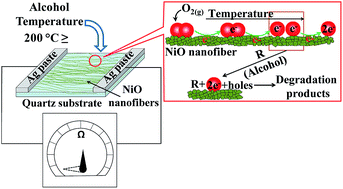Synthesis and characterisation of nickel oxide nanofibre webs with alcohol sensing characteristics†
Abstract
In this study, nickel oxide (NiO) nanofibres were obtained by a sol–gel electrospinning process followed by calcination from an aqueous sol of poly(2-ethyl-2-oxazoline)/nickel acetate tetrahydrate. Thermogravimetric analysis was used to determine the degradation temperature of the composite fibres, so as to get nickel oxide nanofibres. X-ray photoelectron spectroscopy and X-ray diffraction studies revealed the complete elimination of the organic phase from NiO fibres during calcination. The change in grain size with calcination temperature was determined by X-ray diffraction. The defects in fibres resulted in the modification of their Raman spectra as compared with that of a single crystal. The magnetic properties of the fibres were reduced as the calcination temperature was increased; this is due to the presence of non-stoichiometric defects. As the calcination temperature was increased, the amount of defects was reduced, which induced a difference in the band gap energy of the fibres. Sensitivity of the NiO fibres towards five different alcohols was studied, and the sensitivity towards ethanol was the highest.


 Please wait while we load your content...
Please wait while we load your content...